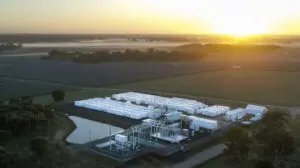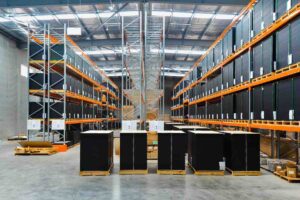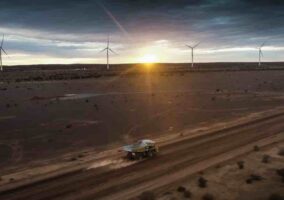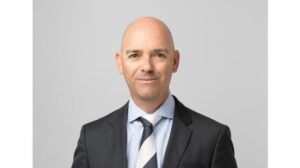Hysata, an Australian hydrogen start-up, has landed another $20.9 million in federal government funding as it revealed plans for “giga-scale” production of what it claims is the world’s most efficient hydrogen electrolyser technology.
The new funding – $20.9 million from Australian Renewable Energy Agency, and a further $3 million from the Queensland government owned Stanwell Corp – was announced at the opening of Hysata’s new headquarters and manufacturing plant in Port Kembla on Monday.
The Hysata technology has emerged from the nearby University of Wollongong and claims an “efficiency rate” of 95 per cent – far beyond that of any other electrolyser technology.
The company will initially build and test a 5MW electrolyser at the facility before shipping it to Queensland where it will operate next to the Stanwell power station.
But Hysata’s Paul Barrett says the company hopes to quickly ramp up to a production rate of 100MW a year, and then to “giga-scale” production. He says “conditional” orders from aspiring green hydrogen end users already total more than 9.4GW of capacity, and the pipeline is approaching 40GW.
“We are going to need a lot of electrolysers,” Barrett says, even with the growing recognition that hydrogen will not be the best solution for passenger cars, home heating and appliances, and other sectors.
But it will still be needed for hard to abate industries such as steel, chemicals, ammonia and heavy transport (shipping etc).
“We need over a trillion dollars of electrolyzers,” Barrett says. “And that’s not a typo, a trillion dollars of electrolyzers to put those hard to abate sectors on the path to net zero.
“So why isn’t the world moving faster? Well, part of the reason is today’s electrolyzers are too expensive. And too inefficient. A disruptive step change of technology is needed to make this sector viable.” And, Barrett says, Hysata has the answer.
Hysata’s unique membrane technology delivers a kg of hydrogen with just 41.5kWh of electricity, compared to more than 50kWh for others.
That 20 gain may not sound much, but when you are thinking in the scale that hydrogen developers do – in millions of tonnes of hydrogen production a year, and tens of gigawatts of wind and solar capacity to create it – that can save billions.
The co-benefit of being more efficient in the production of hydrogen is the creation of less waste heat. Much of the cost of hydrogen electrolysers comes in “balance of plant” costs with systems to deal with the waste heat. In Hysata’s case, that is significantly reduced.
The other appeal, says Barrett, and which flows from that reduced balance of plant, is the ease of manufacturing, partly because it can be so compact and modular.
Hysata already has the backing of some pretty major companies – and its shareholders include the world’s biggest wind turbine manufacturers Vestas, Kiko Energy, Bluescope, Virescent Ventures, and IPGroup.
It also has the backing of Australian and German governments, and ATENA has previously injected $8.9 million to help it create its first 200kW unit, and that is matched by similar funding from Germany through the Hygate program.
“Australia can be a renewable energy powerhouse,” federal energy minister Chris Bowen said at the launch, shortly after announcing the start of consultation for the fourth offshore wind zone, this time in the Illawarra.
“We don’t just want to make renewable energy, we want to make the things that make renewable energy as well, right up and down the supply chain – wind turbines, solar panels, electrolyzers, and inverters,” Bowen said.
“This is the biggest economic transformation our country or the world has ever undertaken.”
The federal government is planning more hydrogen funding through the $2 billion hydrogen headstart program that will be rollout out later this year, and will give funding to at least three major green hydrogen projects. “We’re going to make further announcements about in the very near future. T
Hysata’s Barrett says that after initial testing of the first 5MW electrolyser for Stanwell, the company plans to ramp up top 100MW of annual production by 2025, and its huge new facility in Pot Kembla will be able to accommodate 1GW of annual production.
“This site will also serve as the headquarters for our entire staff, fostering collaboration and fortifying our values-driven culture. We look forward to creating hundreds more local jobs and strengthening Australia’s sovereign manufacturing capabilities as we continue to grow.”
ARENA CEO Darren Miller said the project is a crucial step to enabling purchase orders for the technology.
“Hysata is a great example of Australian innovation leading the way in renewable energy. This electrolyser technology could be a game-changer for renewable hydrogen,” he said.
“The demonstration at Stanwell’s site will be key to unlocking commercial demand for Hysata’s product by proving the technology works at scale.”










